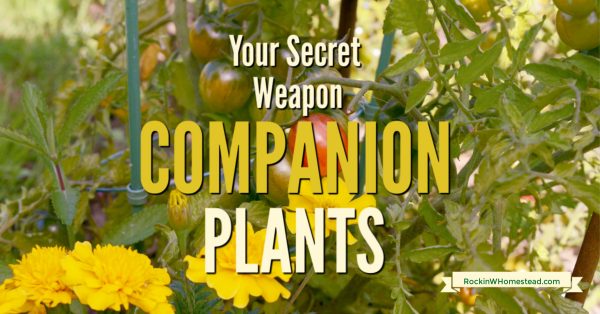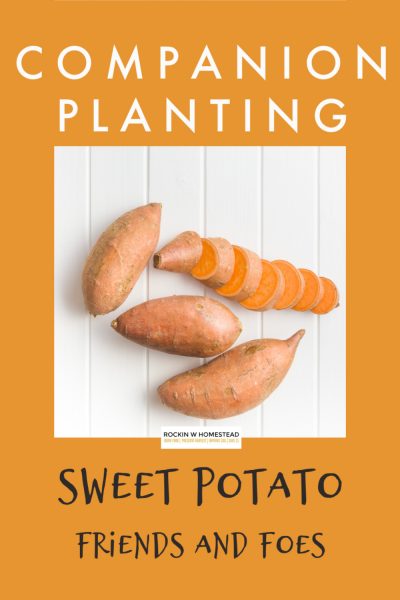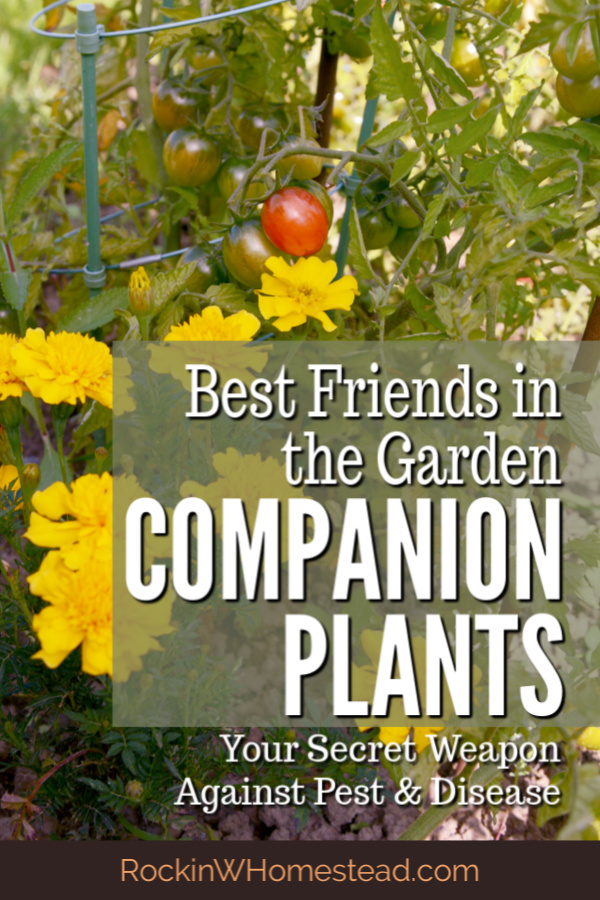Companion plants like being together, they are best friends in the garden. Get the companions for 10 of your favorite vegetable garden plants.

There are many benefits to companion planting. Foremost, they help us by attracting beneficial insects to our garden. Plant companions work together to provide food and shelter, which attracts and protects beneficial insects while they visit your garden.
It can be fun to incorporate companion planting by combining two plants for a particular purpose. Let’s say that your crops are regularly attacked by insects. You can use companions to trap pests, repel them, or hide the plant altogether. Plants can’t attack what they don’t see or don’t like.
Many plants grow well together because they don’t compete for light or rooting space. It’s a win-win situation for both of them.
Ultimately companion planting does these things for your garden:
- Cuts down on the need for chemicals
- Reduces the amount of time you spend looking for and cleaning up pests in the garden
- Allows the plants to benefit from each other by providing shade and attracting pollinators
- Helps the plants in the garden work in harmony by building nutrients in the soil
The biggest benefit of companion planting is adding diversity to your garden. It increases the diversity of your garden plantings is a natural and effective way, so when pests arrive in your vegetable garden the plants won’t be completely wiped out.
Using Companion Plants to Repel Pests in Your Garden
Some plants act as natural pesticides and help to deter garden pests. They can also be used to attract pollinators. The roots of marigold (Tagetes spp) produce a substance that inhibits the growth of weeds and soil pests. To get this effect, use varieties of French Marigold and African Marigold in your garden.
Smelly crops like onion and garlic also repel pests. Their aroma is used to mask the scent of the main crop and make it invisible to the pests. In addition, plants either love or hate these smelly plants, so be careful what they are grown around, they can also stunt the growth of beans.
Some plants are used for “trap cropping,” and are sacrificed to draw pests away from the main crop. Nasturtium is often planted with roses and lettuce to lure aphids away. Chervil will draw slugs away from the leafy greens growing in your garden, and dill is loved by the tomato hornworm.
Companion Plants Attract The Good
Some beneficial weeds naturally till the soil, letting the main crop dig its roots deeper. People often grow clover with tomatoes or corn to improve the quality of the soil. According to Amy Stross at Tenth Acre Farm you can increase the productivity of your permaculture garden by knowing how to harness the power of these just five weeds. View her article “5 Weeds You Want in Your Garden“. You’ll find that they may already be in your garden and you have been looking at them the wrong way!
Many herbs produce pollen and nectar that are needed to attract pollinators like bees and butterflies to your garden. Every garden can harness the flowers of thyme, rosemary, oregano, nasturtium, mint, lavender, sunflower, and lemon balm. Not only will they attract the good guys, but you can also preserve these herbs for tea, cooking, and herbal remedies.
Plants have amazing power. You can actually change the flavor of a neighboring plant by using herbs. The time tested max of mixing tomatoes and basil in the same garden bed improves the flavor of both. Give it a try this year.
Here are 10 of the most common vegetables grown in the garden and their companions. Pay special note to their foes too. These will put a damper on your harvest totals. Caring for companion plantings isn’t any different from how you normally care for your garden. You still need to prepare the soil, plant at the proper time, and water and fertilize as necessary.
Save Pinterest graphics for each of the plant varieties below by visiting my companion planting board.
Bean Companion Plants
- Cabbage will improve soil and yields
- Carrots also improve the soil
- Cucumbers help improve yields
- Marigolds deter pests
- Potatoes protect the bean against the Mexican bean beetle
- Tomato acts as a support plant
Foes – Beans do not like fennel, garlic, leeks, onions or shallots.
Pepper Companion Plants
- Basil, which deters pests
- Chives act as a pollinator; deter unwanted pests and prevent disease
- Chamomile improves the flavor and health of the plant
- Marigold improves plant health and soil health
- Garlic’s pungent scent deters pests and prevents disease
- Nasturtium is a terrific pollinator. It deters pests and acts as a trap crop
- Oregano deters pests and acts as a pollinator
- Sunflower is a shelter crop, helping to pollinate and support plants
- Yarrow supplies nutrients to the soil, improves plant and soil health
Foes -Peppers do not like: beans, fennel, and kohlrabi
Peas Companion Plants
- Beans
- Celery
- Carrots
- Cucumber, peas are good for the soil but tend to compete for space on the trellis
- Corn
- Early potatoes
- Lettuce
- Spinach
- Strawberries
- Eggplant
- Radish
- Turnip
Foes – Peas do not like onion, leek, shallots, garlic, chives
Onion Companion Plants
- Chamomile
- Beets
- Carrots
- Broccoli
- Dill
- Kohlrabi
- Look
- Lettuce
- Strawberries
- Tomatoes
- Summer savory
Foes – Onions do not like asparagus, peas (onions will impart their flavor on these plants)
Squash Companion Plants
- Beans supply nutrients to the soil and also improve yields.
- Chamomile will improve the flavor and is a health improver
- Coriander is a beneficial plant attracting pollinator and deterring pests
- Corn acts as a support and shelter crop
- Dill with its scented leaves, deters pests
- Nasturtium is a trap crop, deterring pests and aiding with pollination.
- Oregano is a beneficial pollinator.
- Radishes, which can be grown as a catch crop and soil improver, will mature much faster.
- Sunflower attracts pollinators
Foes – Squash does not like sage or potato.
Potato Companion Plants
- Bush beans
- Celery
- Corn
- Garlic
- Marigold
- Onion
- Pea
- Radish
- Cabbage
- Eggplant
- Kale
- Lettuce
Foes – Potato does not like asparagus, carrots, cucumber, kohlrabi, melons, tomato, parsnips, squash, turnip, sunflower, sweet potato
Pumpkin Companion Plants
- Beans supply nutrients to the soil and also improve yields
- Chamomile will improve the flavor and is a health improver
- Coriander is a beneficial plant attracting pollinator and deterring pests
- Corn acts as a support and shelter crop
- Dill with its scented leaves, deters pests
- Nasturtium is a trap crop, deterring pests and aiding with pollination
- Oregano is a beneficial pollinator
- Radishes, which can be grown as a catch crop and soil improver, will mature much faster
- Sunflower attracts pollinators
Foes – Pumpkin does not like sage or potato
Cucumber Companion Plants
- Beans supply nutrients to the soil and also improve yields.
- Chamomile will improve the flavor and is a health improver
- Coriander is a beneficial plant attracting pollinator and deterring pests
- Corn acts as a support and shelter crop
- Dill with its scented leaves, deters pests
- Nasturtium is a trap crop, deterring pests and aiding with pollination.
- Oregano is a beneficial pollinator.
- Radishes, which can be grown as a catch crop and soil improver, will mature much faster.
- Sunflower attracts pollinators
Foes – Cucumber does not like sage or potato.
Tomato Companion Plants
- Beans supply nutrients to the soil around tomatoes. They also improve yields.
- Borage will help suppress weeds and is a general health improver for the plants around it.
- Chives are wonderful pollinators and are known to help prevent disease.
- Nasturtium is a trap crop and aids with pollination.
- Oregano is a beneficial pollinator.
- Sage is a shelter crop for tomatoes, protecting it from water damage.
- Sunflower not only attracts pollinators; it also acts as a support and shelter crop.
Foes – Tomato does not like dill, fennel, potatoes, kohlrabi, or corn
 Sweet Potato Companion Plants
Sweet Potato Companion Plants
- Dill
- Thyme
- Beets
- Parsnips
- Beans
- Oregano
- Chives
- Garlic
- Borage
- Chamomile
- Marigold
- Grow after beans & peas, which improve the soil
Foes – Sweet Potato does not like potatoes or other root crops that compete for space
These are some of my favorite books about companion planting. You can find them at Amazon (affiliate links)
Companion planting is one of my favorite ways to increase the harvest in my garden. Not only does it have terrific benefits for pests and diseases, but using companion plants gives you visual variety in the garden. It’s a win all around.





I have companion plants gardened since 1972 but did not realize that there was a dedicated crowd to them until ya’ll’s article today. My Grandma Tek & Poppa taught me that it makes the plants & flowers happier (so that was good enough for me).
BTW I am a new subscriber to Rocking W Homestead. Thank you for your terrific site which I will take great fun in receiving and visiting.
Sincerely, Casey in Phoenix, Arizona